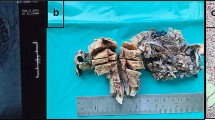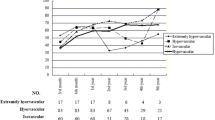Abstract
Purpose
Uterine angiomyolipoma (AML) is a rare condition involving benign tumors composed of varying proportions of blood vessels, fat, and epithelioid or spindled smooth muscle cells. We analyzed the clinicopathological features, diagnosis and treatment methods, and prognosis of uterine AML.
Methods
We retrospectively analyzed the clinical-pathological data of eight patients with pathologically diagnosed uterine AML at a single center from January 2008 to July 2020.
Results
The mean age of the patients was 50 years (range, 41–62). One patient was asymptomatic; the main clinical manifestations of the others included vaginal bleeding (3), menorrhagia (2), abdominal pain (1), and dysmenorrhea with adenomyosis (1). In one case, fat components observed via abdominal computed tomography led to a diagnosis of uterine leiomyolipoma; the rest were diagnosed as uterine leiomyoma (4), uterine fibroid degeneration (2), and pelvic mass (1). The lesions were in the body of the uterus (6), the fundus of the uterus (1), and the broad ligament (1). Seven patients had a focal soft tumor texture, and one had a tough texture; the lesions were yellow (3), yellow-white (3), and pinkish white (2). Surgeries included transabdominal myomectomy (2), transabdominal hysterectomy (2), transabdominal hysterectomy/bilateral salpingo-oophorectomy (2), and laparoscopic total hysterectomy/bilateral salpingectomy (2). The median follow-up time was 72 months. No relapses were reported.
Conclusion
Uterine AML has a low incidence rate and is most likely to occur in perimenopausal women. The clinical manifestations are similar to those of uterine leiomyomas, but AML should be suspected if the internal echo of the uterine tumor is uneven and contains adipose tissue.




Similar content being viewed by others
Availability of data and material
All data and material are fully available without restriction.
References
Folpe AL, Kwiatkowski DJ (2010) Perivascular epithelioid cell neoplasms: pathology and pathogenesis. Hum Pathol 41(1):1–15. https://doi.org/10.1016/j.humpath.2009.05.011
Lam H, Nijmeh J, Henske E (2017) New developments in the genetics and pathogenesis of tumours in tuberous sclerosis complex. J Pathol 241(2):219–225. https://doi.org/10.1002/path.4827
Thway K, Fisher C (2015) PEComa: morphology and genetics of a complex tumor family. Ann Diagn Pathol 19(5):359–368. https://doi.org/10.1016/j.anndiagpath.2015.06.003
Cil A, Haberal A, Hucumenoglu S, Kovalak E, Gunes M (2004) Angiomyolipoma of the uterus associated with tuberous sclerosis: case report and review of the literature. Gynecol Oncol 94(2):593–596. https://doi.org/10.1016/j.ygyno.2004.05.015
Mulchandani NJ, Vimala R (2020) Uterine angiomyolipoma: a case report and review of literature. Indian J Gynecol Oncol. https://doi.org/10.1007/s40944-020-00426-3
Henske E, Jóźwiak S, Kingswood J, Sampson J, Thiele E (2016) Tuberous sclerosis complex. Nature Rev Dis Prim 2:16035. https://doi.org/10.1038/nrdp.2016.35
Giannella L, Delli Carpini G, Montik N, Verdecchia V, Puccio F, Di Giuseppe J, Tsiroglou D, Goteri G, Ciavattini A (2020) Ultrasound features of a uterine perivascular epithelioid cell tumor (PEComa): case report and literature review. Diagnostics. https://doi.org/10.3390/diagnostics10080553
Nguyen J, Ghandehari H, Parra-Herran C, Vicus D (2020) Uterine rupture: an unusual presentation of a uterine perivascular epithelioid cell tumor (PEComa). Int J Gynecol Cancer . https://doi.org/10.1136/ijgc-2020-001837
Braun H, Wheelock J, Amaker B, Seeds J (2002) Sonographic evaluation of a uterine angiolipoleiomyoma. J Clin Ultrasound 30(4):241–244. https://doi.org/10.1002/jcu.10057
Bennett J, Braga A, Pinto A, Van de Vijver K, Cornejo K, Pesci A, Zhang L, Morales-Oyarvide V, Kiyokawa T, Zannoni G, Carlson J, Slavik T, Tornos C, Antonescu C, Oliva E (2018) Uterine PEComas: A morphologic, immunohistochemical, and molecular analysis of 32 tumors. Am J Surg Pathol 42(10):1370–1383. https://doi.org/10.1097/pas.0000000000001119
Conlon N, Soslow R, Murali R (2015) Perivascular epithelioid tumours (PEComas) of the gynaecological tract. J Clin Pathol 68(6):418–426. https://doi.org/10.1136/jclinpath-2015-202945
Parra-Herran C, Howitt B (2019) Uterine mesenchymal tumors: update on classification, staging, and molecular features. Surg Pathol Clin 12(2):363–396. https://doi.org/10.1016/j.path.2019.01.004
Kawauchi S, Nawata H, Yamagata Y, Yaegashi H, Fukunaga M, Moriya T, Furuya T, Sugino N, Sasaki K (2010) Chromosomal imbalances detected by comparative genomic hybridization provide evidence that HMB-45-negative uterine angiomyolipomas belong to the PEComa family. Histopathology 56(7):974–977. https://doi.org/10.1111/j.1365-2559.2010.03567.x
Yaegashi H, Moriya T, Soeda S, Yonemoto Y, Nagura H, Sasano H (2001) Uterine angiomyolipoma: case report and review of the literature. Pathol Int 51(11):896–901. https://doi.org/10.1046/j.1440-1827.2001.01289.x
Acknowledgements
This work was supported by the National Natural Science Foundation of China (No. 81872125), and the local Technology and Development Key Program of Liaoning Province (No. 2019416020).
Funding
This work was supported by the National Natural Science Foundation of China (No. 81872125), and the local Technology and Development Key Program of Liaoning Province (No. 2019416020).
Author information
Authors and Affiliations
Contributions
All authors contributed to the study conception and design. Material preparation, data collection and analysis were performed by Jiao Wang, Qing Yang and Ningning Zhang. The first draft of the manuscript was written by Jiao Wang, Dandan Wang was responsible for critical revision of the manuscript and all authors commented on previous versions of the manuscript. All authors read and approved the final manuscript.
Corresponding author
Ethics declarations
Conflicts of interest
The authors declare no competing interests.
Ethics approval
This study was approved by the Institutional Review Board of Shengjing Hospital of China Medical University.
Consent to participate
Informed consent was obtained from all the patients.
Consent for publication
Informed consent to publish was obtained from all the patients.
Additional information
Publisher's Note
Springer Nature remains neutral with regard to jurisdictional claims in published maps and institutional affiliations.
Rights and permissions
About this article
Cite this article
Wang, J., Yang, Q., Zhang, N. et al. Uterine angiomyolipoma: a clinical analysis of 8 cases and literature review. Arch Gynecol Obstet 304, 171–177 (2021). https://doi.org/10.1007/s00404-021-05992-1
Received:
Accepted:
Published:
Issue Date:
DOI: https://doi.org/10.1007/s00404-021-05992-1




